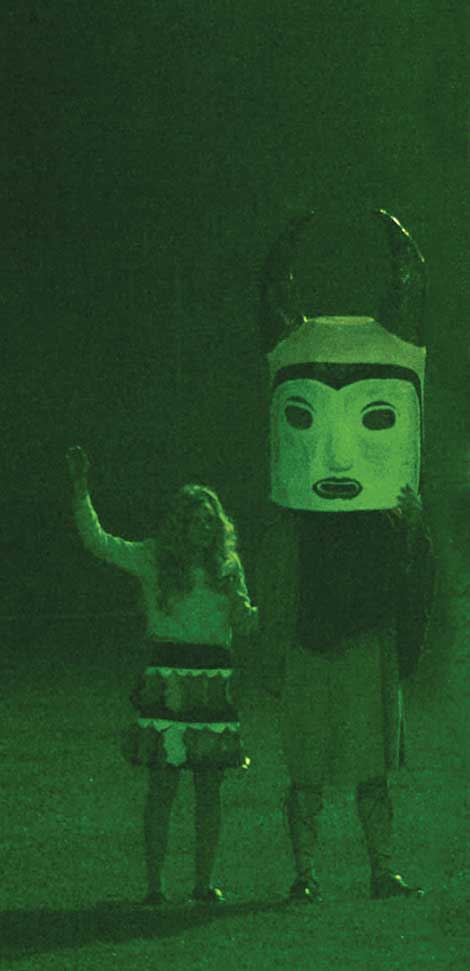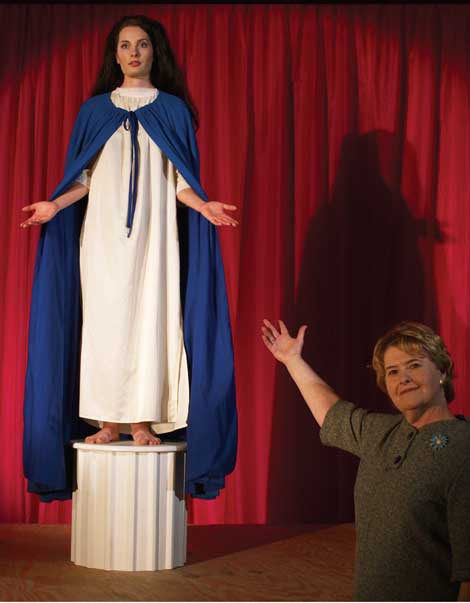Mike Kelley’s first feature length movie takes place mainly at a high school. Cheery bright classrooms are full of 30-year-old sloppy students. Auditoriums stage assemblies with campy musicals and pageants. Gleaming lockers line the polished hallways. It’s a regular Sadie Hawkins Day, where white trash meets Goth.
The opening credits roll against the backdrop of a bleached out sunset over the ocean, with hues of moldy greens and dried-blood reds. An over-the-top symphonic soundtrack accompanies this endless sequence of soap opera sunsets until finally the film’s title Day is Done appears. Next, a harsh juxtaposition of hundreds of slimy earthworms wriggling and slithering to raw psychedelic mind-blowing noise. Then an average-looking high school with your not-so-average student faculty. So far so good, looks and feels like Mike Kelley. Keep it up.
A trio of ballerinas with white painted faces and black leotards dance through the empty hallways. A train whistle blasts from the intercom announcing a change of pace. Vampires and creepy bad-skinned adults make up the school staff who go about their busy day xeroxing and talking on phones and making no eye contact. And no one is aware that everyone is severely fucked up.
This is probably the first 10 minutes of the film. The audience has been laughing the whole time. I had a grin glued on my face. Day is Done is practically a feel-good movie. It’s easy to identify Kelley’s influences in this film, yet his own vision as writer and director comes through loud and clear. His casting, costumes, music and nonsensical plots comprise his signature sensibility. His characters embody every hippie, yippie, punk rocker and performance artist he’s ever encountered, who in turn project Kelley’s own mischief, horror, bad taste, sexploitation, perversion, religion and ugliness. Is it just a coincidence the film’s subtitle is “Extracurricular Activity Projective Reconstructions #2-#32”? No, of course it’s not a coincidence, neither are his film references. Kelley’s having a ball with Day is Done; it’s practically a self-parody, and incidentally a kick-ass soundtrack he and Scott Benzel collaborate on.
Everyone agrees that Mike Kelley is a major American artist whose influence has had an impact on younger artists today. His films can’t boast the same claim, however. That’s not to say his films or videos suck. But I have to say, his filmmaking doesn’t measure up to his art making. His art stands alone as original, whereas his films have whiffs of Waters, Lynch, Meyer, Warhol, Craven and others. Kelley’s art borrows thematic elements, but his films borrow stylistically.
Day is Done practically rips off Waters. For instance, the way he uses children in the film. Pure unabashed exploitation. Waters was famous for this, as of course was W. C. Fields. Other scenes are right out of Pink Flamingos and Kelley is actually able to pull it off (which must make Waters green with envy nowadays). Like Waters, Kelley draws on real experiences. Day is Done’s premise is taken literally from a high school yearbook — particularly the quotes and captions that go with the school photos. You know, the ones you or I never had next to our picture: “Second place Prom Queen,” “Member of the Speech Club,” “Captain of the volleyball team.” I would guess Kelley never did either. Like Waters, Kelley doesn’t have to go far for his inspiration. He finds it in his own backyard.
They say truth is stranger than fiction. What about when it’s exaggerated and exploited? So is it even truth then? I wondered about that, and about what sets Kelley’s Day is Done apart from John Waters. I thought about how void of beauty nearly all of Kelley’s work are. He’s the artist responsible for turning “warm and fuzzy” into germ-infested bombs. Then I thought about that Keats line, “Beauty is truth.” It seems weird that I would think of truth and beauty when there was absolutely neither present in Day is Done. Both are conspicuous by their absence. It would seem more fitting if I thought about filth and lies.
Maybe Kelley doesn’t see beauty in truth. Some things are ugly and it could be that truth is one of them. War is ugly and certainly true. But it’s not truth. So therefore it’s not beauty. Kelley’s work is deep-rooted, and probably stems from the truth, but he never finds beauty in it the way, say, Larry Clark does. Kelley’s preoccupation with high school and the deeply troubled period of adolescence might represent a genuinely negative experience in high school, similar to Clark’s own obsession with adolescence. But Kelley adds a layer of irony, with his faux fascination and adoration of these “normal” people from the high school yearbook, and all their extracurricular activities. So maybe it’s not truth after all. Maybe it’s even envy. These are the jocks, the squares, the goody-two shoes, who may have fascinated, but most likely repelled the likes of Kelley and other outsiders. To him, normal people were the freaks, like Marilyn in The Munsters. And admittedly, it’s hard to imagine Mike Kelley as a high school student.
But don’t worry. There’s really no reason to ponder, pontificate, deconstruct or intellectually wank off to Kelley’s Day is Done. You can just sit and laugh. The film certainly has merit and I think everyone should go see it, especially if you like comedies. But don’t expect a plot, don’t expect much sense, and don’t expect beauty.
Photos by Fredrik Nilsen; courtesy of the artist and Gagosian Gallery



